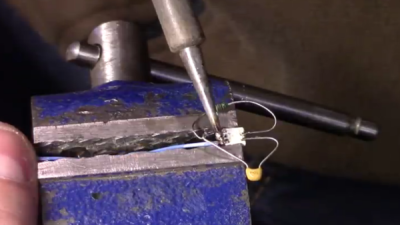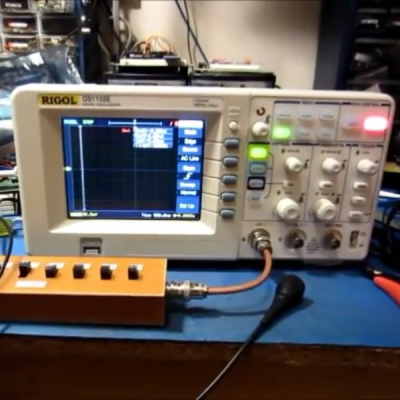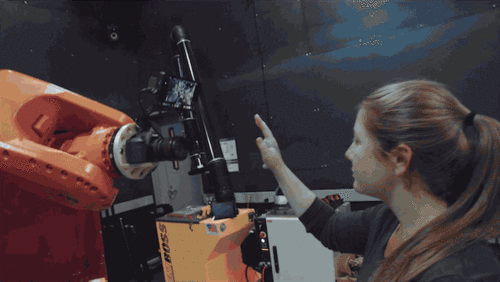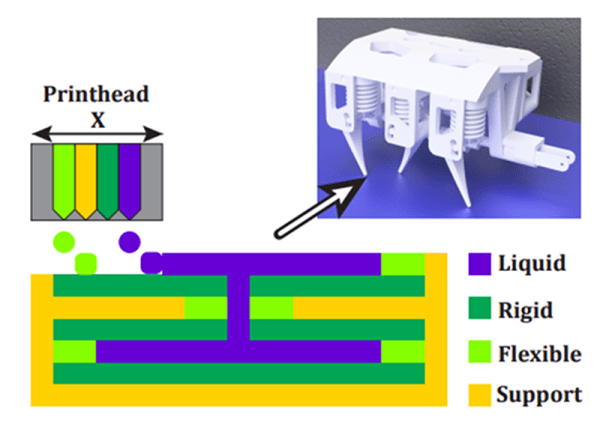[Dave] wanted to learn more about the ARM architecture, so he started with an image of the ARMV1 die. If you’ve had some experience looking at CPU die, you can make some pretty good guesses at what parts of the chip have certain functions. [Dave], however, went further. He reverse engineered the entire ALU–about 2,200 transistors worth.
RGB LED Ceiling Display
 Disco Floor’s are passé. [dennis1a4] turned them upside down and built an awesome RGB LED ceiling display using some simple hardware and a lot of elbow grease. His main room ceiling was exactly 32 ft x 20 ft and using 2 sq. ft tiles, he figured he could make a nice grid using 160 WS2812B RGB LEDs. A Teensy mounted in the ceiling does all the heavy lifting, with two serial Bluetooth modules connected to it. These get connected to two Bluetooth enabled NES game controllers. Each of the NES controller is stuffed with an Arduino Pro Mini, a Bluetooth module, Li-Ion battery and a USB charge controller.
Disco Floor’s are passé. [dennis1a4] turned them upside down and built an awesome RGB LED ceiling display using some simple hardware and a lot of elbow grease. His main room ceiling was exactly 32 ft x 20 ft and using 2 sq. ft tiles, he figured he could make a nice grid using 160 WS2812B RGB LEDs. A Teensy mounted in the ceiling does all the heavy lifting, with two serial Bluetooth modules connected to it. These get connected to two Bluetooth enabled NES game controllers. Each of the NES controller is stuffed with an Arduino Pro Mini, a Bluetooth module, Li-Ion battery and a USB charge controller.
Bluetooth is in non-secure mode, allowing him to connect to the Teensy, and control the LEDs, from other devices besides the NES controllers. The Teensy is mounted at the centre of the ceiling to ensure a good Bluetooth link. Programming required a lot of thought and time but he did manage to include animations as well as popular games such as Snake and Tetris.
 The hard part was wiring up all of the 160 LED pixels. Instead of mounting the 5050 SMD LED’s on PCBs, [dennis1a4] wired them all up “dead bug” style. Each pixel has one LED, a 100nF decoupling capacitor, and 91 ohm resistors in series with the Data In and Data Out pins – these apparently help prevent ‘ringing’ on the data bus. Check the video for his radical soldering method. Each SMD LED was clamped in a machine shop vice, and the other three parts with their leads preformed were soldered directly to the LED pins.
The hard part was wiring up all of the 160 LED pixels. Instead of mounting the 5050 SMD LED’s on PCBs, [dennis1a4] wired them all up “dead bug” style. Each pixel has one LED, a 100nF decoupling capacitor, and 91 ohm resistors in series with the Data In and Data Out pins – these apparently help prevent ‘ringing’ on the data bus. Check the video for his radical soldering method. Each SMD LED was clamped in a machine shop vice, and the other three parts with their leads preformed were soldered directly to the LED pins.
The other tedious task was planning and laying out the wiring harness. Sets of 10 LEDs were first wired up on the shop bench. He then tacked them up to the ceiling and soldered them to the 14 gauge main harness. The final part was to put up the suspended ceiling and close the 2 sq. ft. grids with opaque plastic.
[dennis1a4] did some trials to figure out the right distance between each LED and the panel to make sure they were illuminated fully without a lot of light bleeding in to adjacent panels. This allowed him to get away without using baffles between the tiles.
Check out the video to see a cool time-lapse of the whole build.
Madeline Gannon The Robot Tamer!
Let’s be honest. Who doesn’t want an industrial six-axis robot arm in their garage to do their bidding? Introducing [Madeline Gannon], the Robot Tamer!
The only tricky part is… if you received an industrial six-axis robot arm, would you be able to control it to do your bidding (easily)? Having taken robotics courses myself in college, and worked with ABB robots like this one, I can tell you, it’s not exactly plug-and-play. Yeah, there’s the teach pendant and you can pretty quickly teach the robot to do a repetitive task well, but unless you’re setting up your own mini manufacturing line — what’s the point? You’re going to want to inject some CNC code or something and have it carve you a sculpture! Or pour you a mixed drink I guess…
Maybe [Madeline] has the answer. Working as an artist in residence at Pier 9, she’s created wearable markers and a motion capture system that allows a giant ABB robot to see, and respond to your movements in a shared space.
Hackaday Links: December 20, 2015
If you don’t have a Raspberry Pi Zero right now, you’re not getting one for Christmas. Who would have thought a $5 Linux computer would have been popular, huh? If you’re looking for a new microcontroller platform you can actually buy, the Arduino / Genuino 101 is available in stores. This was released a few months ago, but it still looks pretty cool: DSP, BTLE, and a six-axis sensor.
If you don’t know [David], the Swede, you should. He’s the guy that launched a glider from a high altitude balloon and is one of the biggest advocates of tricopters. Now he bought an airplane wing for his front yard. It was an old Swedish air force transport aircraft being broken up for scrap. Simply awesome.
Chocolate chips. Now that the most obvious pun is out of the way, here’s how you make DIP8 cookie cutters.
[Barb] is over at the Crash Space hackerspace in LA, and she has a YouTube channel that goes over all her creations. This week, it’s a layered wood pendant constructed out of many layers of veneer. Take note of the 3M 77 spray glue used for the lamination and the super glue used as a clear, hard finish.
Star Wars was released and we have a few people digging through the repertoire to see what [John Williams] lifted for the new movie. Here’s musical Tesla coils playing the theme for the Force.
Flickr gives you a full gigabyte of storage, but only if you upload JPEGs, GIFs, and PNGs. That doesn’t prevent you from using Flickr as your own cloud storage.
We know two things about [Hans Fouche]: he lives in South Africa and he has a gigantic 3D printer. His latest creation is an acoustic guitar. It may not sound great, but that’s the quality of the recording. It may not play great, but he can fix that with some acetone vapor. It would be very interesting to see 3D printing used in a more traditional lutherie context; this printer could easily print molds and possibly even something to bend plywood tops.
Starting in 1990, [deater] would make a yearly Christmas-themed demo on his DOS box. You can really see the progression of technology starting with ANSI art trees written in BASIC, to an EGA graphical demo written with QBASIC to the last demo in 96 made with VGA, and SoundBlaster effects written in Turbo Pascal and asm.
3D Printed Hydraulics
[Robert MacCurdy] at MIT wants to change how people think about hydraulics. Using fluid can be very useful in systems like robots, but it is often the case that the tubing that carries hydraulic fluid is not an integrated part of the overall design. [MacCurdy] and his colleagues have modified a 3D printer to allow it directly include hydraulic components as it prints.
The idea is simple. The team started with a printer that uses a liquid ink that is UV cured to produce solid layers. The printer has the ability to use multiple liquids, and [MacCurdy] uses hydraulic fluid (that does not UV cure) as one of the print materials. Just as you can use a 3D printer to build structures within other structures, printing the hydraulics allows for complex closed systems that use the UV-cured resin as mechanical parts that can transfer pressure to and from the hydraulic system.
No Spectrum Analyser? No Problem!
In the Bad Old Days, a spectrum analyser was a big piece of expensive machinery that you’d have on your bench next to your oscilloscope. And while good ones still cost a ton of money, [rheslip] shows you how to turn your VISA-compatible scope into a decent spectrum analyser for the low, low price of nothing. Watch it in action in the video below the break.
 If your scope is relatively recent, like this side of the late 1990s, it might support National Instrument’s VISA: virtual instrument software architecture. [rheslip]’s Rigol scope does, and he uses PyVisa, a Python wrapper for the NI-VISA libraries to download the raw samples from the ‘scope and then crunches the FFTs out on his laptop.
If your scope is relatively recent, like this side of the late 1990s, it might support National Instrument’s VISA: virtual instrument software architecture. [rheslip]’s Rigol scope does, and he uses PyVisa, a Python wrapper for the NI-VISA libraries to download the raw samples from the ‘scope and then crunches the FFTs out on his laptop.
There are definitely drawbacks to this method. The sampling depth of the scope is eight bits, which limits his maximum signal-to-noise ratio, and the number-crunching and data transfer are slow, resulting in a 2 Hz refresh rate. But once the data has made it across to his laptop, [rheslip] can run the FFTs at whatever sample length he wants, resulting in very high frequency resolution.
Indeed, we’re thinking that there’s all sorts of custom filters and analysis that one could do with raw access to the oscilloscope’s data. Why haven’t we been doing this all along? Any of you out there have cool VISA tricks that you’d like to share?
Printing Objects Directly From Fallout 4
Fallout 4 was released about a month ago, and although we don’t have a ‘took an arrow to the knee’ meme like Bethesda’s last game, there are ample opportunities for cosplay and printing out deathclaws and mirelurks on a 3D printer. How do you turn files hidden away in a game’s folders into a real, printed object? It’s actually pretty easy and [Angus] is here to tell you how.
The files for Fallout enemies and items can be readily accessed with the Bethesda Archive Extractor, although this won’t give you files that a 3D printer can understand. You’ll get a .NIF file, and NifSkope can convert the files found in the Fallout archives to an .OBJ file any 3D modeling program can understand. The next step from there is taking the .OBJ file into Meshmixer and fixing everything with Netfabb. After that, it’s off to the printer.
[Angus] printed his model of a Deathclaw in ABS in multiple parts, gluing them together with a little bit of acetone. This didn’t go exactly as planned; there were some contaminants in the ABS that turned into a white film on the black ABS. This was ultimately fixed with XTC-3D, the 3D print coating everyone is experimenting with.
The finished product is a solid yellow but completely smooth 3D model of one of the toughest enemies in Fallout 4. The only thing left to do is paint the model. The best way to proceed at this point is probably doing what model builders have been doing for decades – an airbrush, and hundreds of tiny bottles of paint. [Angus] is opening up his YouTube comments for suggestions, and if you have a better idea he’s looking for some help.
Continue reading “Printing Objects Directly From Fallout 4”

















